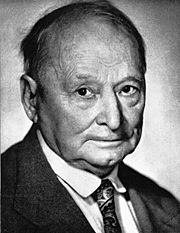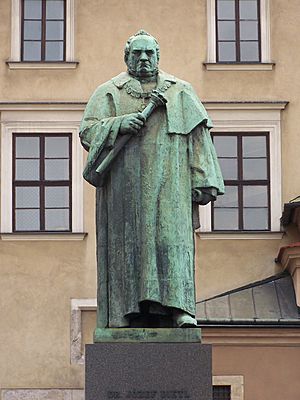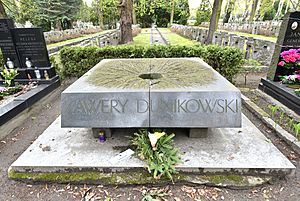Xawery Dunikowski facts for kids
Quick facts for kids
Xawery Dunikowski
|
|
|---|---|
 |
|
| Born | 24 November 1875 Kraków, Austria–Hungary
|
| Died | 26 January 1964 (aged 88) Warsaw, Poland
|
| Nationality | Polish |
| Awards | |
Xawery Dunikowski (Polish pronunciation: [ksaˈvɛrɨ duɲiˈkɔfskʲi]; 24 December 1875 – 26 January 1964) was a famous Polish sculptor and artist. He is known for his unique sculptures and art inspired by his experiences. He also survived the difficult times in Auschwitz concentration camp.
Contents
Early Life and Art Training
Dunikowski was born in Kraków, a city he loved very much. When he was twelve, his family moved to Warsaw. After finishing technical school, he studied sculpture. His teachers were Boleslaw Syrewicz and Leon Wasilkowski.
At age twenty-one, Dunikowski returned to Kraków. He studied sculpture at the School of Fine Arts. His teachers there included Konstanty Laszczka and Alfred Daun. He also studied painting with Jan Stanisławski. He graduated with top honors after three years.
Teaching and Travel
In 1902, Dunikowski began teaching sculpture. He taught at the Academy of Fine Arts in Warsaw. He held this important teaching job until 1909. Then, he became the head of the Sculpture Department. This was at the Jan Matejko Academy of Fine Arts in Kraków.
Just before World War I started, Dunikowski traveled to Paris. He stayed in France from 1914 to 1920. During this time, he served for five years in the French Foreign Legion.
In 1921, he came back to Kraków. He took on the role of Head of Faculty of Sculpture. While teaching, he helped many Polish sculptors. Some of his students became famous artists themselves.
Surviving World War II
Dunikowski was arrested by the Germans on May 15, 1940. He was sent to the Auschwitz concentration camp on June 26, 1940. His prisoner number was 774. His arrest stopped his work on a sculpture series. It was called Heads from the Kraków Palace. These sculptures were based on busts found in old Renaissance castles.
Life in Auschwitz was very hard for the artist. He felt like he had "died" there. He refused requests from guards to make models of the camp. Even though he was older, he became very sick in 1942. He was almost chosen for a terrible fate. But another Polish prisoner saved his name from a list.
In September 1943, he faced danger again. He was accused of being part of a resistance group. He was sentenced to be shot. However, he became ill again and was sent to the infirmary. His sentence was then reduced. By 1944, he was still in the hospital. He began to draw portraits of other prisoners. These drawings had to be secretly taken out of the camp. The ones that made it out were sent back to Kraków.
Dunikowski was still recovering when the Soviet Red Army freed Auschwitz. This happened on January 27, 1945. By 1946, he was well enough to return to his teaching job. He also started working again on his Heads from the Kraków Palace sculptures.
Later Life and Legacy
By the time he returned to his normal life, Dunikowski was seventy years old. He began creating larger artworks. Many of these were connected to his Auschwitz experiences. After the war, he became interested in combining art with buildings. He also created public monuments. Two famous ones are the Monument of the Liberation of the Region of Warmia and Mazury in Olsztyn and the Revolutionary Effort at Góra Świętej Anny.
Dunikowski lived to see his art displayed in many places. His works were shown in Kraków and Warsaw. In the 1950s, they were also shown in Moscow and Venice.
In 1955, a film documentary was made about his workshop. It was called Idę do słońca (I am Going toward the Sun). Another famous series of his sculptures was shown in the film. These were called Kobiety brzemienne (Pregnant Women).
In the same year, Dunikowski became a professor. He taught at the Academy of Fine Arts in Warsaw. He also taught at the State Higher School of Visual Arts in Wrocław.
Xawery Dunikowski passed away in 1964 at the age of eighty-eight. He left behind many important artworks. Some of his most famous sculptures include Macierzyństwo (Motherhood, 1900), Skupienie (Concentration), and Fatum (Fate, 1904). He also created the sculpture series the Women of Nieborów and the Jesuits' Circle. Many illustrations and portraits are also part of his legacy.
Dunikowski is considered one of the best Polish sculptors of the 20th century. He is buried in the Alley of the Meritorious in Powązki Military Cemetery, Warsaw. A former student, Barbara Zbrożyna, created the sculpture on his tomb.
Museum
The old Warsaw palace of Królikarnia now holds a museum dedicated to Dunikowski. Many of his famous works are displayed in the park around the museum. One notable sculpture there is The Soul Escaping the Body (1918), made of sandstone.
See also
 In Spanish: Xawery Dunikowski para niños
In Spanish: Xawery Dunikowski para niños



